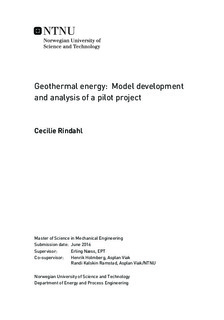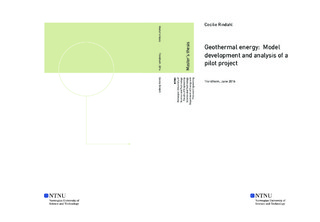| dc.description.abstract | The objective of this study is to develop a calculation method taking into account the thermal interaction between several deep boreholes. Based on a literature study on heat transfer models, a hybrid model combining an existing numerical model with the analytical line source solution is developed. The main advantage of this model is that the accuracy of the numerical solution is maintained, but the grid complexity and computation time remains small when modelling a field with several boreholes. Time-varying heat loads are accounted for by using a temporal superposition technique. The model is used to study the thermal interaction between deep boreholes (> 500 m). The influence of separation distances between boreholes and heat rate are evaluated for operation periods up to 20 years. All the simulations are performed using a coaxial collector in the boreholes due to their good thermal performance and large flow area, which is especially important in deep boreholes. Doubling the heat extraction rate is shown to have a larger influence on the fluid outlet temperature than reducing the separation distance by half.
This thesis is written in parallel with the construction of a pilot project with deep boreholes in Asker, Norway, which are intended to cover a part of the base load demand for heating. Based on this pilot project, a case study of two 800 m deep boreholes with typical values for ground thermal conductivity and geothermal gradient is performed. Criteria regarding the minimum distance between the boreholes and maximum heat extraction rates are suggested, based on the resulting temperature level in the boreholes. When assuming an initial average borehole temperature of 13 C and a constant heat extraction rate throughout the year, the two boreholes combined can provide a total energy amount of 340 MWh per year.
Thermal response testing using a constant heat injection rate is a common method to estimate the thermal properties of the borehole. In this work a numerical model is used to simulate thermal response tests, and the results are analyzed with the line source solution to obtain the ground thermal conductivity. An evaluation of the traditional response test showed that this method is not accurate for deep boreholes, mainly due to the significant temperature and heat rate variations along the borehole axis. Additionally, a large power source would be required to conduct this type of test in a deep borehole. Alternative methods are tested, first using a constant inlet temperature and a variable heat rate through the direct use of cold tap water as circulation fluid. Due to unsatisfactory results, the method is improved by using a variable mass flow and thereby obtaining a constant heat rate throughout the test. The tests are simulated and analyzed with local borehole wall and fluid temperature measurements. It is shown that a minimum difference of 10 degrees between the inlet temperature and the undisturbed ground temperature is required to avoid large mass flows and inaccurate conductivity estimations. Applying this criterion, the thermal conductivity is estimated with an error of less than 3 %. However, an actual field test will naturally contain additional sources of errors. | |

